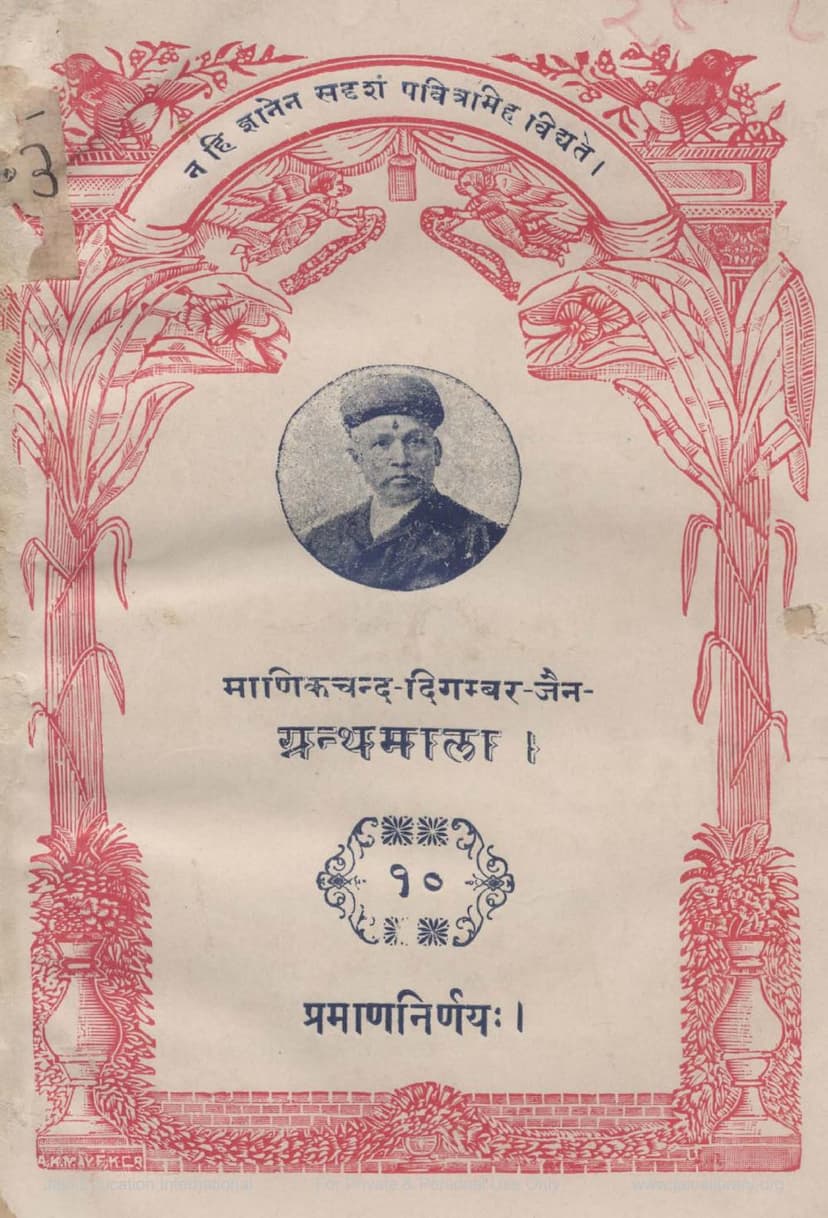Pramana Nirnaya
Added to library: September 2, 2025

Summary
Here's a comprehensive summary of the Jain text "Pramana Nirnaya" by Muni Ratnaprabha Suri (as indicated by the provided catalog link and common attribution), based on the provided pages:
Book Title: Pramana Nirnaya (Determination of Valid Knowledge) Author(s): Muni Ratnaprabha Suri (though the pages mention Rajsuri, Indralal Shastri, and Khubchand Shastri as editors/compilers, the primary author is Muni Ratnaprabha Suri, who is a renowned Jain philosopher and logician). Publisher: Manikchand Digambar Jain Granthamala Samiti Catalog Link: https://jainqq.org/explore/003100/1
Core Subject:
"Pramana Nirnaya" is a foundational text in Jain logic and epistemology, focused on defining and differentiating the sources of valid knowledge (Pramanas) within the Jain philosophical framework. It delves deeply into the nature of knowledge itself and how we can reliably ascertain the truth about reality.
Key Concepts and Structure (Based on the provided pages):
The text begins with a Mangalacharan (auspicious invocation) to Lord Vardhamana (Mahavira). The main body of the provided text focuses on the Pramana Lakshana Nirnaya (Determination of the Characteristics of Pramanas) and the Pratyaksha Nirnaya (Determination of Direct Perception).
1. Pramana Lakshana Nirnaya (Determination of the Characteristics of Pramanas):
- Definition of Pramana: The text establishes that Pramana is samyag-jnana (right knowledge). This is because it is the most effective means (sadhaka-tama) for achieving the act of cognizing (pramiti-kriya). This effectiveness is only possible if the knowledge is right; it cannot be due to inert matter (achetana) or incorrect knowledge (asamya-jnana).
- Role of Instruments (Karanas): While sensory organs and inferential signs (indriya-linga) are instruments for knowledge, their role is considered secondary or instrumental (aupacharika). The primary instrument is samyag-jnana itself. The text argues that inert instruments cannot directly dispel ignorance (avyutpatti) because they lack the nature of definite determination (vyavasaya-atmaka).
- The Nature of Determination (Vyavasaya): Right knowledge is characterized by determination. This determination is described as having a dual nature: pravritti-rupa (active/assertive) and nivritti-rupa (cessative/eliminative of doubt). It's not solely assertive or solely eliminative. This dual nature allows for the determination of specific objects, even in complex situations or when experienced sequentially or simultaneously.
- The Object of Knowledge (Artha): The text discusses the nature of the object of knowledge. It is defined as that which is cognized by knowledge and exists outside of it (samvedana-bahir-bhuta). A debate is presented, likely with Buddhist or other idealist schools, regarding whether the object is truly external or merely a projection of consciousness. The Jain position, as presented, emphasizes the external reality of the object.
- The Self's Role in Cognition: The text touches upon whether knowledge is self-illuminating or requires another cognizer. The Jain view, as implied, supports the idea that the self's nature is consciousness, and this consciousness, through the process of cognition, understands both itself and the external world.
2. Pratyaksha Nirnaya (Determination of Direct Perception):
- Definition of Pratyaksha: Pratyaksha is defined as knowledge that is clear and distinct (spashta-avabhasi).
- Defining Clarity (Spashta): The text explores what constitutes clarity. It dismisses simplistic definitions like "comprehension of differences" (vishesha-avabodha) or knowledge associated with light (aloka-parikalita-grahanam), as these definitions are either too broad or too narrow. The Jain explanation leans towards a special purity or clarity arising from the self's inherent nature and the absence of internal impurities (antara-mala-vislesh-nibandhana).
- The Debate on External Objects: A significant portion is dedicated to refuting the view that knowledge of external objects is merely an imposition or interpretation and that true reality lies only in consciousness. The text argues for the reality of external objects and the direct apprehension of them through knowledge.
- The Role of Instruments in Pratyaksha: The text debates whether sensory contact (indriya-sannikarsa) is essential for Pratyaksha. It presents arguments that challenge the necessity of physical contact in all cases of direct perception, suggesting that some forms of direct perception might be internal or subtle.
- The Debate on the Nature of Mind (Manas): The text discusses whether the mind (manas) is an external physical entity or an aspect of the soul. The Jain position leans towards a subtle aspect of the soul, whose subtle impurities are overcome, allowing for clear perception.
- The Four-fold Classification of Pratyaksha: The text outlines the four types of sensory perception (indriya-pratyaksha) as understood within the Jain tradition:
- Avagraha: The initial perception of an object, grasping its general nature.
- Iha: An attempt to further investigate or inquire about the perceived object.
- A-vaya: A definite conclusion or ascertainment about the object.
- Dharana: Retention or memory of the correctly perceived object. These stages are presented as progressively moving towards clearer and more definitive knowledge.
- The Debate on the Soul's Nature in Liberation (Moksha): The text engages with different philosophical views on the state of the soul in liberation, particularly refuting ideas of the soul becoming undifferentiated consciousness or merging with a universal consciousness (Brahman). The Jain position emphasizes the soul retaining its unique, pure consciousness even in liberation.
Overall Argumentation and Style:
The "Pramana Nirnaya" is characterized by its rigorous dialectical approach. It presents various philosophical viewpoints (likely from Buddhist, Nyaya, Mimamsa, and Sankhya schools) and then systematically refutes them using logical arguments and Jain principles. The text emphasizes the empirical grounding of knowledge and the existence of an external reality, which can be reliably known through valid means of knowledge. It also highlights the importance of the subtle, internal aspects of perception and the limitations of purely sensory or inferential knowledge.
Significance:
This text is crucial for understanding the epistemological foundations of Jainism, establishing a clear framework for what constitutes valid knowledge and how it is acquired. It defends the Jain worldview against opposing philosophical systems through sophisticated logical analysis. The detailed discussions on the nature of perception and the internal stages of cognition are particularly valuable.